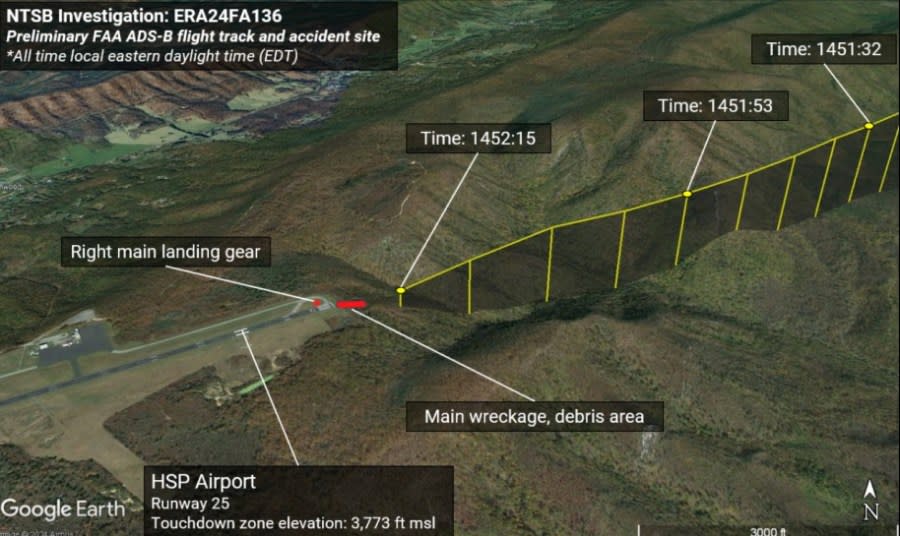Timeline of Events: NTSB releases preliminary report for fatal Ingalls Field Airport crash

HOT SPRINGS, Va. (WFXR) — The National Transportation Safety Board (NTSB) has released its findings into its preliminary investigation of the Ingalls Field Airport (HSP) crash that resulted in the death of five people on March 10.
As we previously reported, the private jet was set to land at HSP when it crashed just 200 away from the runway. The plane fell into several trees and caught fire.
Throughout the investigation, NTSB discovered that the plane departed from Fort Lauderdale/ Hollywood International Airport in Fort Lauderdale, Florida. The passengers Alfredo Diez, Kseniia Shanina, and Nicholas Diez planned to attend a conference in Hot Springs, and the flight crew, Claudio Jose Alberto Colmenares Perez and the first officer, Gagan Gopasandra Srinivas Reddy was scheduled to continue to Teterboro Airport (TEB), in New Jersey.
PREVIOUS COVERAGE: NTSB releases new information about Ingalls Field Airport crash
After reviewing the flight track data, investigators learned that around 2:30 p.m. on March 10, the flight crew checked in with the Washington Air Route Traffic Control Center and was informed of the current weather conditions. During this time, the controller inquired with the flight crew about their approach conduct at HSP.
Shortly after, the flight crew requested to descend from 7,000 to 6,000 feet mean sea level to land at HSP.
According to the report, the flight crew requested clearance and radar vectors for the approach and were subsequently cleared to approach.
The controller’s last contact with the flight crew was at 2:47 p.m. At this time, the crew advised the controller they wanted to cancel their instrument flight rules flight plan with the flight service station upon landing.
A review of the Aviation Routine Weather Reports at the airport found two reports were issued. One was 20 minutes before the crash and another a few minutes after. Investigators learned that an airport staff member at HSP, monitoring the common traffic advisory frequency, heard two calls announcing the crew was conducting an approach to land on runway 25.
Shortly after, the staff member heard the plane go down and saw smoke rising from the end of the runway.

Debris from the wreck was found about 150 ft from the initial impact point. While collecting evidence from the scene, investigators located the cockpit and both engines. The plane’s cockpit voice recorder was sent to the NTSB laboratory in Washington, D.C.
After analyzing the wind conditions during the crash, NTSB learned that around 2:55 p.m., winds were around 21 mph with gusts around 43 mph. Investigators found that visibility was clear for about 10 miles and scattered clouds were reported 2,000 feet above ground level.
The report states that the pilot in command Claudio Jose Alberto Colmenares Perez held an airline transport pilot certification. He was issued a fire-class medical certificate in December 2023. According to the operator’s electronic pilot logbook, he completed 65 hours and 55 hours were in the accident’s airplane make and mode.
The second in command, Gagan Gopasandra Srinivas Reddy held a commercial pilot certificate with airplane single, multi-engine land, and instrument airplane ratings. The license was missed in November of 2023. According to the report, he logged 1,068 flight hours and 136 hours were in the same plane made and model from the crash.
WFXR News will continue to follow this story and update you as additional information is made available.
For the latest news, weather, sports, and streaming video, head to WFXRtv.

